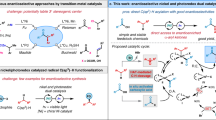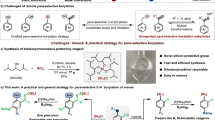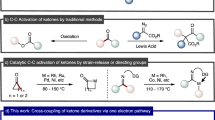Abstract
The direct functionalization of C–H bonds has drawn the attention of chemists for almost a century. C–H activation has mainly been achieved through four metal-mediated pathways: oxidative addition, electrophilic substitution, σ-bond metathesis and metal-associated carbene/nitrene/oxo insertion. However, the identification of methods that do not require transition-metal catalysts is important because methods involving such catalysts are often expensive. Another advantage would be that the requirement to remove metallic impurities from products could be avoided, an important issue in the synthesis of pharmaceutical compounds. Here, we describe the identification of a cross-coupling between aryl iodides/bromides and the C–H bonds of arenes that is mediated solely by the presence of 1,10-phenanthroline as catalyst in the presence of KOt-Bu as a base. This apparently transition-metal-free process provides a new strategy with which to achieve direct C–H functionalization.
This is a preview of subscription content, access via your institution
Access options
Subscribe to this journal
Receive 12 print issues and online access
$259.00 per year
only $21.58 per issue
Buy this article
- Purchase on Springer Link
- Instant access to full article PDF
Prices may be subject to local taxes which are calculated during checkout




Similar content being viewed by others
References
Jones, W. & Fehe, F. Comparative reactivities of hydrocarbon carbon–hydrogen bonds with a transition-metal complex. Acc. Chem. Res. 22, 91–100 (1989).
Labinger, J. A. & Bercaw, J. E. Understanding and exploiting C–H bond activation. Nature 417, 507–514 (2002).
Dyker, G. (ed.) Handbook of C–H Transformations. Applications in Organic Synthesis (Wiley-VCH, 2005).
Godula, K. & Sames, D. C–H bond functionalization in complex organic synthesis. Science 312, 67–72 (2006).
Bergman, R. G. Organometallic chemistry: C–H activation. Nature 446, 391–393 (2007).
Sawyer, D. T., Sobkowiak, A. & Matsushita, T. Metal [MLx; M = Fe, Cu, Co, Mn]/hydroperoxide-induced activation of dioxygen for the oxygenation of hydrocarbons: oxygenated Fenton chemistry. Acc. Chem. Res. 29, 409–416 (1996).
Walling, C. Intermediates in the reactions of Fenton type reagents. Acc. Chem. Res. 31, 155–157 (1998).
MacFaul, P. A., Wayner, D. D. M. & Ingold, K. U. A radical account of ‘oxygenated Fenton chemistry’. Acc. Chem. Res. 31, 159–162 (1998).
Goldstein, S. & Meyerstein, D. Comments on the mechanism of the ‘Fenton-like’ reaction. Acc. Chem. Res. 32, 547–550 (1999).
Gore, P. H. The Friedel–Crafts acylation reaction and its application to polycyclic aromatic hydrocarbons. Chem. Rev. 55, 229–281 (1955).
Olah, G. A. (ed.) Friedel-Crafts and Related Reactions (Wiley, 1964).
Shilov, A. E. & Shul'pin, G. B. Activation and Catalytic Reactions of Saturated Hydrocarbons in the Presence of Metal Complexes (Kluwer, 2000).
Davies, H. M. L. & Beckwith, R. E. J. Catalytic enantioselective C–H activation by means of metal-carbenoid-induced C–H insertion. Chem. Rev. 103, 2861–2904 (2003).
Díaz-Requejo, M. M. & Pérez, P. J. Coinage metal catalyzed C–H bond functionalization of hydrocarbons. Chem. Rev. 108, 3379–3394 (2008).
Doyle, M. P., Duffy, R., Ratnikov, M. & Zhou, L. Chem. Rev. 110, 704–724 (2010).
Alberico, D., Scott, M. E. & Lautens, M. Chem. Rev. 107, 174–238 (2007).
McGlacken, G. P. & Bateman, L. M. Recent advances in aryl–aryl bond formation by direct arylation. Chem. Soc. Rev. 38, 2447–2464 (2009).
Ackermann, L., Vicente, R. & Kapdi, A. R. Transition-metal-catalyzed direct arylation of (hetero)arenes by C–H bond cleavage. Angew. Chem. Int. Ed. 48, 9792–9826 (2009).
Shilov, A. E. & Shul'pin, G. B. Activation of C–H bonds by metal complexes. Chem. Rev. 97, 2879–2932 (1997).
Jia, C. et al. Efficient activation of aromatic C–H bonds for addition to C–C multiple bonds. Science 287, 1992–1995 (2000).
Chen, X., Engle, K. M., Wang, D.-H. & Yu, J.-Q. Palladium(II)-catalyzed C–H activation/C–C cross-coupling reactions: versatility and practicality. Angew. Chem. Int. Ed. 48, 5094–5115 (2009).
Brennführer, A., Neumann, H. & Beller, M. Palladium-catalyzed carbonylation reactions of aryl halides and related compounds. Angew. Chem. Int. Ed. 48, 4114–4118 (2009).
Lyons, T. W. & Sanford, M. S. Palladium-catalyzed ligand-directed C–H functionalization reactions. Chem. Rev. 110, 1147–1169 (2010).
Ritleng, V., Sirlin, C. & Pfeffer, M. Ru-, Rh- and Pd-catalyzed C–C bond formation involving C–H activation and addition on unsaturated substrates: reactions and mechanistic aspects. Chem. Rev. 102, 1731–1770 (2002).
Willis, M. C. Transition metal catalyzed alkene and alkyne hydroacylation. Chem. Rev. 110, 725–748 (2010).
Mkhalid, I. A. I., Barnard, J. H., Marder, T. B., Murphy, J. M. & Hartwig, J. F. C–H activation for the construction of C–B bonds. Chem. Rev. 110, 890–931 (2010).
Chin, C. S., Won, G., Chong, D., Kim, M. & Lee, H. Carbon–carbon bond formation involving reactions of alkynes with group 9 metals (Ir, Rh, Co): preparation of conjugated olefins. Acc. Chem. Res. 35, 218–225 (2002).
Trost, B. M., Toste, F. D. & Pinkerton, A. B. Non-metathesis ruthenium-catalyzed C–C bond formation. Chem. Rev. 101, 2067–2096 (2001).
Conejero, S., Paneque, M., Poveda, M. L., Santos, L. L. & Carmona, E. C–H bond activation reactions of ethers that generate iridium carbenes. Acc. Chem. Res. 43, 572–580 (2010).
Sun, C.-L., Li, B.-J. & Shi, Z.-J. Pd-catalyzed oxidative coupling with organometallic reagents via C–H activation. Chem. Commun. 46, 677–685 (2010).
Fagnou, K. & Lautens, M. Rhodium-catalyzed carbon–carbon bond forming reactions of organometallic compounds. Chem. Rev. 103, 169–196 (2003).
Kuninobu, Y., Nishina, Y., Takeuchi, T. & Takai, K. Manganese-catalyzed insertion of aldehydes into a C–H bond. Angew. Chem. Int. Ed. 46, 6518–6520 (2007).
Waltz, K. M. & Hartwig, J. F. Selective functionalization of alkanes by transition-metal boryl complexes. Science 277, 211–213 (1997).
Chen, H., Schlecht, S., Semple, T. C. & Hartwig, J. F. Thermal, catalytic, regiospecific functionalization of alkanes. Science 287, 1995–1997 (2000).
Cho, J.-Y., Tse, M. K., Holmes, D., Maleczka, R. E. Jr & Smith, III, M. R. Remarkably selective iridium catalysts for the elaboration of aromatic C–H bonds. Science 295, 305–308 (2002).
Naota, T., Takaya, H. & Murahashi, S.-I. Ruthenium-catalyzed reactions for organic synthesis. Chem. Rev. 98, 2599–2660 (1998).
Lersch, M. & Tilset, M. Mechanistic aspects of C–H activation by Pt complexes. Chem. Rev. 105, 2471–2526 (2005).
Li, Z., Brouwer, C. & He, C. Gold-catalyzed organic transformations. Chem. Rev. 108, 3239–3265 (2008).
Chen, X., Hao, X.-S., Goodhue, C. E. & Yu, J.-Q. Cu(II)-catalyzed functionalizations of aryl C–H bonds using O2 as an oxidant. J. Am. Chem. Soc. 128, 6790–6791 (2006).
Phipps, R. J., Grimster, N. P. & Gaunt, M. J. Cu(II)-catalyzed direct and site-selective arylation of indoles under mild conditions. J. Am. Chem. Soc. 130, 8172–8174 (2008).
Brasche, G. & Buchwald, S. L. C–H functionalization/C–N bond formation: copper-catalyzed synthesis of benzimidazoles from amidines. Angew. Chem. Int. Ed. 47, 1932–1934 (2008).
Ueda, S. & Nagasawa, H. Synthesis of 2-arylbenzoxazoles by copper-catalyzed intramolecular oxidative C–O coupling of benzanilides. Angew. Chem. Int. Ed. 47, 6411–6413 (2008).
Xu, L.-M., Li, B.-J., Yang, Z. & Shi, Z.-J. Organopalladium(IV) chemistry. Chem. Soc. Rev. 39, 712–733 (2010).
Phipps, R. J. & Gaunt, M. J. A meta-selective copper-catalyzed C–H bond arylation. Science 323, 1593–1597 (2009).
Liu, W. et al. Organocatalysis in cross-coupling: DMEDA-catalyzed direct C–H arylation of unactivated benzene. J. Am. Chem. Soc. doi:ja103050x (2010).
Vallée, F., Mousseau, J. J. & Charette, A. B. Iron-catalyzed direct arylation through an aryl radical transfer pathway. J. Am. Chem. Soc. 132, 1514–1516 (2010).
Liu, W., Cao, H. & Lei, A. Iron-catalyzed direct arylation of unactivated arenes with aryl halides. Angew. Chem. Int. Ed. 49, 2004–2008 (2010).
Yanagisawa, S., Ueda, K., Taniguchi, T. & Itami, K. Potassium t-butoxide alone can promote the biaryl coupling of electron-deficient nitrogen heterocycles and haloarenes. Org. Lett. 10, 4673–4676 (2008).
Deng, G., Ueda, K., Yanagisawa, S., Itami, K. & Li, C.-J. Coupling of nitrogen heteroaromatics and alkanes without transition metals: a new oxidative cross-coupling at C–H/C–H bonds. Chem. Eur. J. 15, 333–337 (2009).
Jonkheijm, P., van der Schoot, P., Schenning, A. P. H. J. & Meijer, E. W. Probing the solvent-assisted nucleation pathway in chemical self-assembly. Science 313, 80–83 (2006).
Kumpf, R. A. & Dougherty, D. A. A mechanism for ion selectivity in potassium channels: computational studies of cation–pi interactions. Science 261, 1708–1710 (1993).
Acknowledgements
The authors acknowledge support for this work from NSFC (grant nos 20672006, 20821062, GZ419) and the ‘973’ Project from the MOST of China (2009CB825300). The authors also thank J. Zhang at East China Normal University and N. Jiao at the Medical School of Peking University and their students for repeating our experiments. The polishing of the English and the constructive comments from K. Itami at Nagoya University and C. He from the University of Chicago are greatly appreciated.
Author information
Authors and Affiliations
Contributions
Z.-J.S. conceived the project. C.-L.S., H.L. and D.-G.Y. performed the experiments and analysed the data and contributed equally to this work. M.Y., X.Z., X.-Y.L., K.H. and S.-F.Z. worked on product isolation and purification. C.-L.S., B.-J.L. and Z.-J.S. wrote the paper. C.-L.S. wrote the Supplementary Information and contributed other related materials.
Corresponding author
Ethics declarations
Competing interests
The authors declare no competing financial interests.
Supplementary information
Supplementary information
Supplementary information (PDF 1817 kb)
Rights and permissions
About this article
Cite this article
Sun, CL., Li, H., Yu, DG. et al. An efficient organocatalytic method for constructing biaryls through aromatic C–H activation. Nature Chem 2, 1044–1049 (2010). https://doi.org/10.1038/nchem.862
Received:
Accepted:
Published:
Issue Date:
DOI: https://doi.org/10.1038/nchem.862
This article is cited by
-
Rapid access to polycyclic N-heteroarenes from unactivated, simple azines via a base-promoted Minisci-type annulation
Nature Communications (2022)
-
RETRACTED ARTICLE: The amine-catalysed Suzuki–Miyaura-type coupling of aryl halides and arylboronic acids
Nature Catalysis (2021)
-
Direct C(sp2)–H alkylation of unactivated arenes enabled by photoinduced Pd catalysis
Nature Communications (2020)
-
(ZrO)2Fe2O5 as an efficient and recoverable nanocatalyst in C–C bond formation
Journal of the Iranian Chemical Society (2019)
-
The role of organic electron donors in the initiation of BHAS base-induced coupling reactions between haloarenes and arenes
Science China Chemistry (2019)



